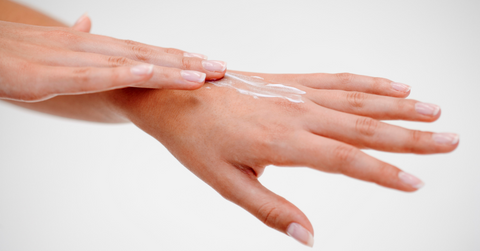We use our hands to paint, carry our children, wave around when explaining a stressful or exciting situation and pour a cup of coffee or tea. We also use them for less interesting things like working and paying for groceries. All in all, our hands are always exposed, there, in front of us and everyone else, and when something like eczema develops, it can affect us both psychologically and physically.
A great number of people have hand eczema, but not all know how to handle it, treat it, and come to an improvement.
But, helpful information awaits you in the following post, where you can learn more about hand eczema and its treatment.
WHAT IS HAND ECZEMA?

Hand eczema or hand dermatitis is a common skin disorder, which can be acute in some cases and chronic in others. It occurs on the palms and/or the back of the hands as itchy, red, and scaly skin.
Anyone of any age and gender can be affected by it, although it tends to happen more often in young adult females. And it is more likely to develop in people who already have atopic dermatitis or in people who have jobs that require frequent hand washing or working with chemicals.
It is mainly due to the irritants that this eczema occurs, but some contact allergies may also contribute.
CAUSES, SYMPTOMS, AND TREATMENT
Causes are often combined.
It can develop due to genetics, injuries, immune reactions and allergens, irritants, etc.
Irritants can be :
- detergents
- solvents
- acids
- specific cosmetic products
- cold
- heat
- friction
These irritants disturb the skin’s barrier function and damage the stratum corneum (skin's outermost layer). It is a barrier that protects against the external environment and prevents water loss. Almost all forms of hand dermatitis are due to the disruption of this layer which is usually followed by inflammation and transepidermal water loss.
This can lead to cracks, fissures, and further impairment of the barrier function.
Hand eczema often affects people who work in catering, also hairdressers, cleaners, and health care workers. Every job that requires working with irritants, coming in contact with chemicals, or constant hand washing may lead to, or worsen hand eczema.
Some of the symptoms are redness, pain, itchiness, and dryness to the point of peeling and cracking of the skin.
Sometimes small itchy blisters can appear on the palms. This is a specific type of hand eczema called dyshidrotic eczema.
Something that can't be seen, but is a part of the problem is how eczema affects us mentally. Many people isolate themselves from the world, feel stressed, skip social gatherings, and have self-esteem issues. So except for classic treatment of the skin disorder as it is, some people might need counseling and professional advice on how to feel good again.
Treatment and prevention start with skincare.

Restoration of the epidermal barrier is essential for any type of dermatitis, and proper and regular skincare is the first step to recovery.
Avoiding irritants and excessive hand washing is vital along with the regular use of barrier recovering and protecting creams.
Emollients that can be used for hand eczema can be simple petroleum-based ones or some that contain vital stratum corneum lipids such as ceramides.
To get the best effects it is recommended to use emollients immediately after showering, that way they can “lock-in” moisture.
Except for moisturizing, proper skincare also refers to the use of lukewarm instead of hot water, choosing fragrance-free cleansers, avoiding alcohol-based ones, and gently patting the skin after showering.
Another thing that can help prevent flare-ups and make everyday tasks less irritating for the skin is wearing protective gloves. They can also be combined with emollients.
Put some emollient on the skin after showering, and then gloves over that before going to bed.
Quality bamboo viscose gloves for all ages can be found in the eczema relief store.
Topicals
One of the most common ways to deal with hand eczema is the use of topical corticosteroids for inflammation control.
For better absorption sometimes they are combined with urea, especially when it's a chronic case.
But, side effects are possible with continuous use of mid-potency topical steroids (more than 3 to 4 weeks).
Possible side effects include atrophy (decreased thickness, loss of elasticity, etc) and telangiectasia (small dilated blood vessels, spider veins).
Unlike topical steroids, tacrolimus and pimecrolimus, do not cause dermal atrophy or telangiectasia and may be useful for treatment in sensitive areas and chronic skin diseases.
Side effects are usually burning and itching at the application site. But they may have black block warnings for rare malignancies.
Antibiotics

In cases of infection, antibiotic therapy can be prescribed.
Antistaphylococcal antibiotics (cephalexin, dicloxacillin) are effective treatments. Topical or oral antifungal medications can also be used, depending on the results of a skin scraping.
Light therapy
UV radiation decreases inflammation and leads to local immunosuppression.
The entire light spectrum may be used, from visible, and ultraviolet to infrared.
And the big plus for this therapy is that it has no systematic side effects.
But it should be considered that long-term use can increase the risk of skin malignancy.
Psychological treatment
Having a skin disease is very stressful, and stress can also be a cause of skin disease, so the whole cycle between stress and skin disease seems never-ending. Mindfulness, stress management, relaxation techniques, meditation, and hypnotherapy might help with this part of the treatment.
Hand eczema is a problem that has to be taken seriously and treated properly. It includes both professional care and care at home, which is where consistency is key.
Apart from consistency, products that we use are of great importance. At the eczemareliefestore we offer some great options to make sure your everyday skincare is proper and can offer relief to your irritated and sensitive skin.
SOURCES
-
DermNet, “Hand dermatitis”, DermNetNZ
-
Adam D. Perry and John P. Trafeli, “Hand dermatitis: review of etiology, diagnosis and treatment ”, The Journal of the American Board of Family Medicine May 2009, Jabfm
-
National Eczema Association, “Hand eczema”, NationalEczema
-
Elsner, P. and Agner, T. (2020), Hand eczema: treatment. J Eur Acad Dermatol Venereol, Onlinelibrery.wiley
-
National Eczema Society, “The mind-body connection”, Eczema.org.

